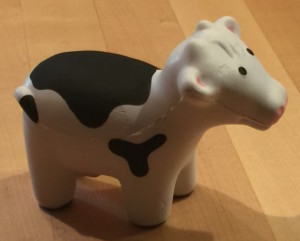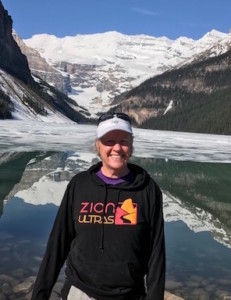By Michele Straube for EDRblog.org.
 I realized recently that my projects involved cows at the beginning, middle and end of my career, and a squishy stress toy named Consensus Cow has become my go-to mediation / facilitation tool in the past year. A random coincidence, no doubt, but a good reason for Consensus Cow to help me reflect on the past 20+ years as an environmental mediator in Utah to see what’s changed with respect to collaboration; what’s stayed the same; and maybe what needs to change.
I realized recently that my projects involved cows at the beginning, middle and end of my career, and a squishy stress toy named Consensus Cow has become my go-to mediation / facilitation tool in the past year. A random coincidence, no doubt, but a good reason for Consensus Cow to help me reflect on the past 20+ years as an environmental mediator in Utah to see what’s changed with respect to collaboration; what’s stayed the same; and maybe what needs to change.
I began my bovine projects in 1980 as the Commonwealth of Pennsylvania co-counsel in the Three Mile Island restart proceeding to ensure that emergency evacuation protocols included moving local farmers’ cows. Then in the early 1990s, I did a policy analysis of regulatory mechanisms for concentrated animal feeding operations (CAFO’s, aka feedlots); and in the later part of my career from 2008-2017, I mediated three grazing collaborations in Utah.
My Consensus Cow came about when an EDR Program student fellow included a “consensus cow” sketch in some website redesign mock-ups. I was on my way to yet another “dynamic” meeting of a grazing collaboration at the time, and immediately had to have one as a visual reminder for the group so that they could have productive conversations instead of yelling at each other. The only toy cow I could find is the one pictured here, and now my constant companion in mediations, facilitations and trainings.
Everyone wants to “collaborate,” but not everyone wants (or knows how) to behave collaboratively. When I was in private practice in the early 1980s, fellow attorneys questioned whether my more collaborative approach to representing corporate entities (negotiating with regulatory agencies rather than litigating every new regulation or notice of violation) was ethical. Was I really advocating vigorously for my clients? Agency leaders and scientists I worked with as an attorney and policy consultant until the mid-1990s were sold on the idea of agency expertise, and were insistent that it was inappropriate to involve non-agency interests in development or implementation of policy or regulation.
Get notified when new articles are posted to the EDR blog – sign up for our email list »
Fast forward decades, and most everyone loves the word “collaboration” and professes they want to “collaborate.” I choose to see that as progress. But I wonder whether it’s more talk than walk. Several mediation or collaboration participants over time have told me how magical they found the ultimate result of consensus (agreement that all parties are satisfied with and will help to implement), but often cannot describe how consensus was reached. When I explain it to them, they resist the very things that made the collaborative process they participated in work. While the “magic” of collaboration is multi-faceted, there are a few key components, which still need to be internalized within agency leadership (both in organizational policy and individual leaders) to become “the way we do business.”
It takes planning and courage to collaborate successfully. Success does not come from putting a bunch of stakeholders in the room and saying “let’s collaborate.” Merely having a facilitator or mediator in the room is not a recipe for success either. Yet this is the collaborative “process design” I continue to see many decision-makers implement, wondering why it often doesn’t work.
Effective collaboration comes from thoughtful planning and process design. As described in a recent EDR Blog, conducting an assessment before scheduling the meeting room and inviting participants is essential to creating a process that has a good chance of success. The assessment research and interviews inform who to invite (you wouldn’t expect someone to implement a decision they were not part of inventing, would you?), how to frame the issues for discussion (who will bring creative ideas if you invite them to a discussion about eliminating or reducing snowmobiling / grazing / insert your favorite use of public lands?), and which collaborative activities are needed (is everyone working with the same facts? any data gaps?).
Effective collaboration requires a willingness to try something new, suspend all-knowingness, co-create with others. Collaboration is a way of exercising leadership that “shares” power – not necessarily the ultimate decision-making power, but the power to shape the issues under discussion (don’t assume you know all aspects of the problem you’re trying to solve), and the possible solutions (don’t assume you have “the answer”). This is a very different – and scary — approach for most leaders. Yet having the courage to incorporate a variety of perspectives in the problem-solving conversation, and to consider “out of the box” approaches to the problem at hand, often results in a decision that “sticks” (i.e., that is not challenged and will be implemented) for the very reason that it does address the varying stakeholders’ concerns.
Effective collaboration happens early and often. Imagine your spouse comes home one day and says “I haven’t told you about it, dear, but I’ve been thinking and researching over the past few months for a new place to live; I propose we move to Timbuktoo; do you love that idea as much as I do?”! This describes the prevalent notice-and-comment approach to environmental and natural resource decision-making, and the public’s reactions are predictable. I am encouraged to hear many recognize that collaboration presents an alternate path.
We have two ears and one mouth for a reason. Given the vitriol and entrenched position-taking evident in our current political climate, there is a strong public call for more “dialogue” and “civility.” I couldn’t agree more – I’ve often said that our work (ADR, Alternative Dispute Resolution) should really be called Additional Dialogue Required – but am concerned that many of us have forgotten what civil dialogue really is. And we may be confusing the two terms – civility in and of itself is not dialogue.
One recent situation stands out for me as an example of what “dialogue” is not. Good questions for future discussion were raised in a panel. When I followed up individually with the panelist who raised the questions about the potential for follow-up conversations, I got a clear “no,” along with the statement that the only point was to demonstrate civil conversation across ideological differences. Further discussion to explore whether any agreement was possible on the questions raised was not on the agenda.
Luckily, I have also witnessed plenty of recent examples where people with opposing viewpoints have been willing to engage in conversation to explore their differences in a constructive way, so I can retain some confidence that real dialogue is possible. Examples where individuals have listened to each other’s perspective without judgment. Where they’ve asked for clarification if they didn’t understand, and were able to accurately describe the other perspective. Where they’ve suggested a possible solution they thought addressed both perspectives, and asked “why does that not work for you” when the response was not fully positive. Where they’ve then reworked the possible solution to better address both perspectives for as long as it took to reach a mutually satisfactory result.
Real dialogue engages our two ears in active listening, and our one mouth in something other than restating the same conclusions over and over. Those who do not engage in such dialogue generally do not make forward progress on their goals, and they can stall forward progress on others’ goals they disagree with. I look forward to the day where more leaders choose to use dialogue and collaboration to make implementable change.
But back to Consensus Cow: the grazing collaboration participants appreciated her attendance at that “dynamic” meeting, but also suggested that she could not be successful because she was “the wrong kind of cow!” What they didn’t overtly realize is that allowing creative ideas into the room and committing to chew on those ideas until a workable solution could be devised is part of the “magic” of the collaborative process. Maybe it takes a dairy cow to move ranchers, conservation groups and land management agencies past impasse.
 I have been honored to work with the EDR Program over the past five years to build collaborative capacity through educating graduate students, hosting the Program on Collaboration (quarterly Dialogues on Collaboration and the Short Course on Effective Natural Resources Collaboration), serving as a third party neutral in model projects, and evaluating collaborative efforts to identify best practices and lessons learned. I am moving on to new adventures, and look forward to watching the continued growth of collaborative problem-solving in Utah and the Mountain West from the sidelines.
I have been honored to work with the EDR Program over the past five years to build collaborative capacity through educating graduate students, hosting the Program on Collaboration (quarterly Dialogues on Collaboration and the Short Course on Effective Natural Resources Collaboration), serving as a third party neutral in model projects, and evaluating collaborative efforts to identify best practices and lessons learned. I am moving on to new adventures, and look forward to watching the continued growth of collaborative problem-solving in Utah and the Mountain West from the sidelines.
Michele Straube is the Founding Director of the Environmental Dispute Resolution Program at the S.J. Quinney College of Law, University of Utah. After August 31, 2017, she will be exploring all sorts of activities that start with “re-“: retiring, reinventing, redesigning, recreating, relaxing. Michele can continue to be reached at michele.straube@law.utah.edu.
